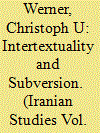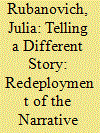| Srl | Item |
| 1 |
ID:
186905


|
|
|
|
|
| Summary/Abstract |
This study proposes an innovative, triangular close reading of three Persian authors: Nezāmi, Golshiri, and Mandanipour. It argues that the two modern authors, Hushang Golshiri with his famous novella Shāh-e siyāhpushān, the “King of those clad in black,” and Shahriar Mandanipour in his Censoring an Iranian Love Story, are not only bound to each other in a close master-disciple relationship, but also consciously expound on the subversive potential of the twelfth-century poet Nezāmi. In the process, the divide between modern and classical narrative traditions in Persian literature is bound to disappear, allowing for novel interpretations and perspectives on Nezāmi and for his epics to be heard.
|
|
|
|
|
|
|
|
|
|
|
|
|
|
|
|
| 2 |
ID:
186904


|
|
|
|
|
| Summary/Abstract |
This article explores the remaniement of three episodes current in the Perso-Arabic Alexander tradition—i.e., Eskandar's confrontation with the Indian king Fur; Eskandar's visit to Queen Qeydāfeh; and Eskandar's encounter with the Gymnosophists—in the anonymous Persian Eskandarnāmeh, a medieval epic narrative in prose (dāstān; ca. 12th–14th c.). Through extensive comparative evidence from other genres, primarily narrative poetry (Ferdowsi's Shāhnāmeh, Nezāmi's Sharafnāmeh and Eqbālnāmeh), mirabilia (ʿajāyeb), and exegetical works (qesas al-anbeyāʾ and tafsir), this study engages with how the modalities of the dāstān genre, with its strong leaning towards traditional oral storytelling, affect the narrative choices Eskandarnāmeh's author makes in treating these themes. In so doing, this article attempts to develop a more informed assessment of the strategies and devices which, activated both on the production and reception planes, generate competing interpretations of well-known plots recast in different narrative modes.
|
|
|
|
|
|
|
|
|
|
|
|
|
|
|
|